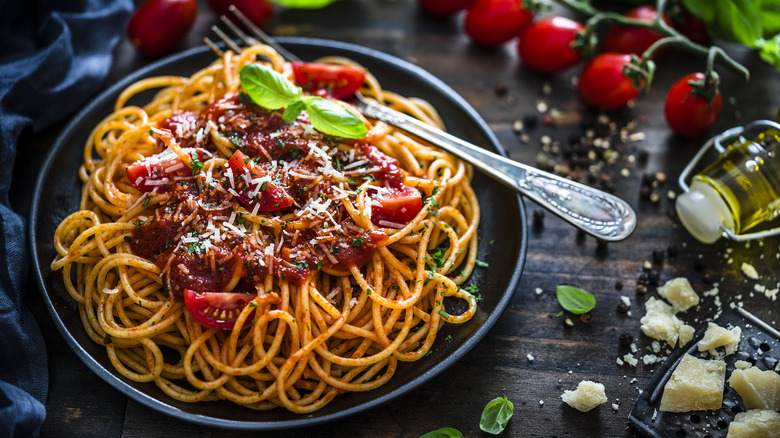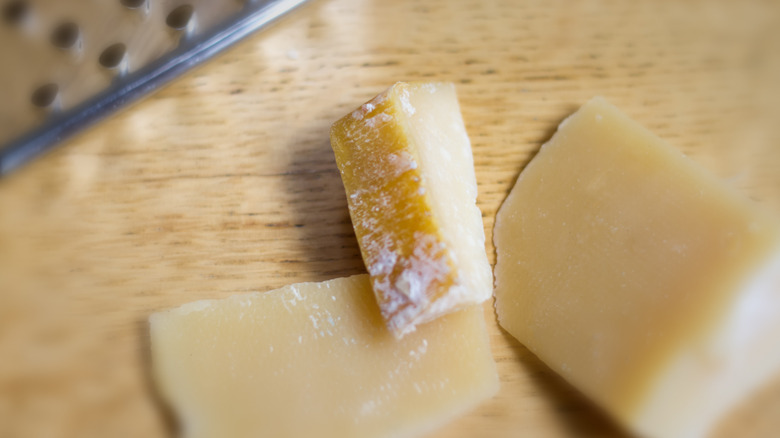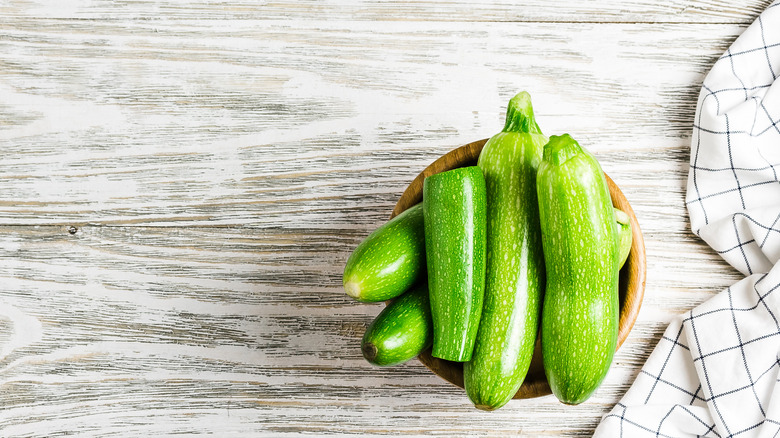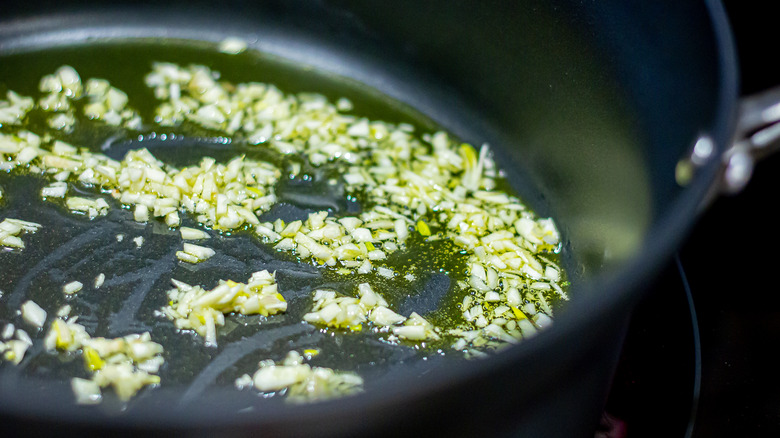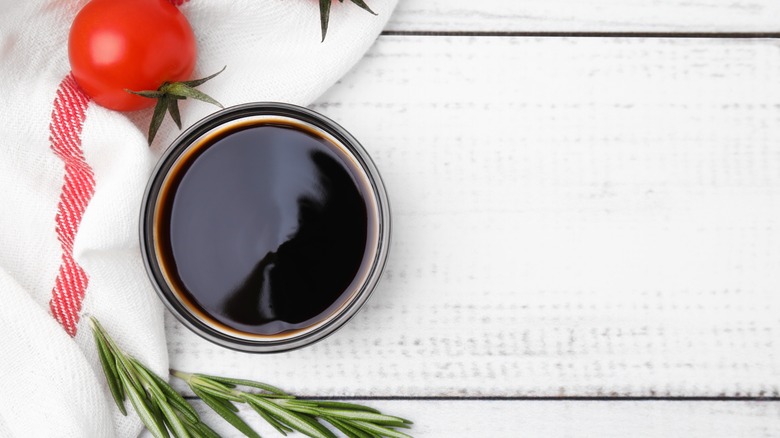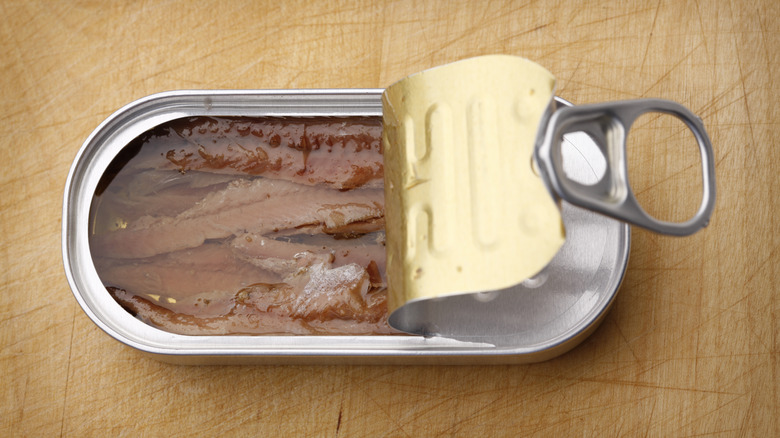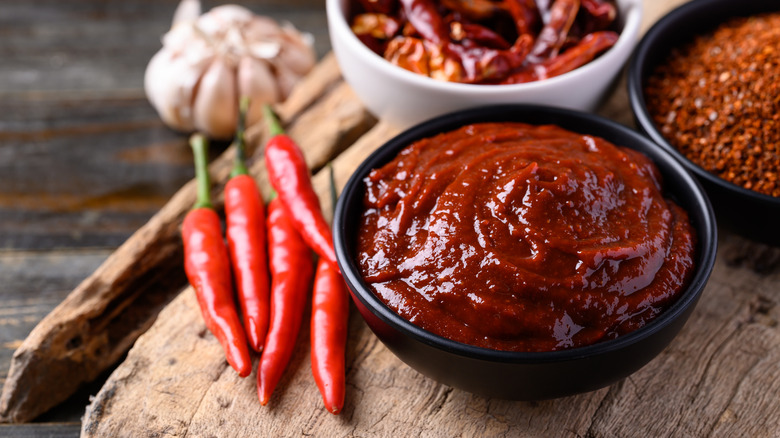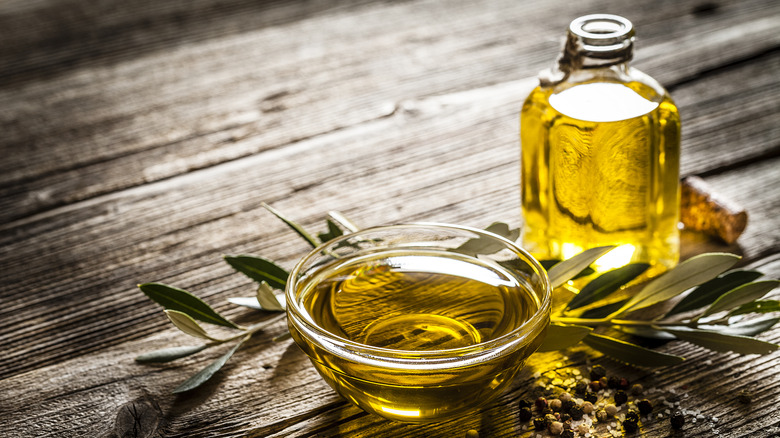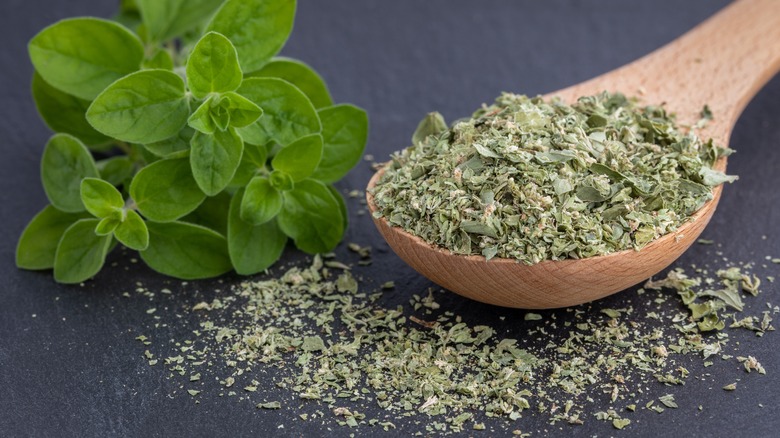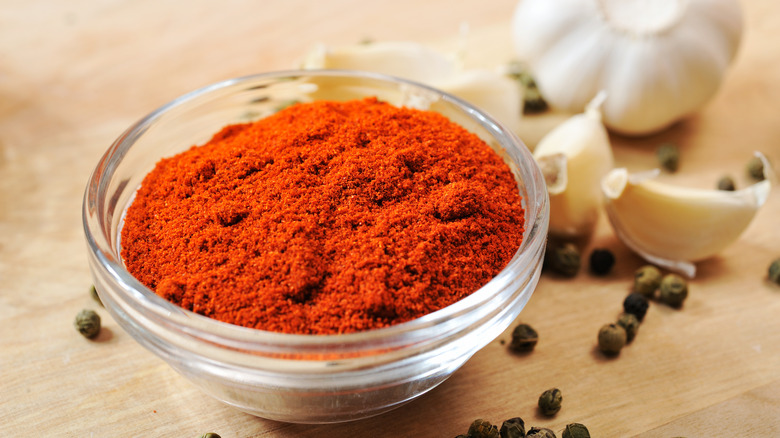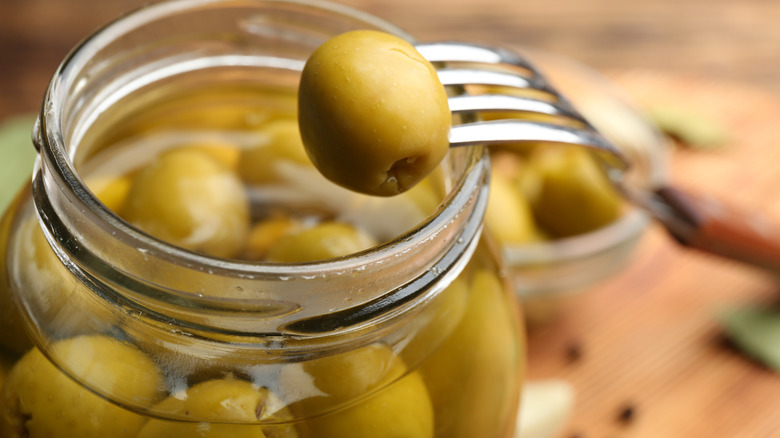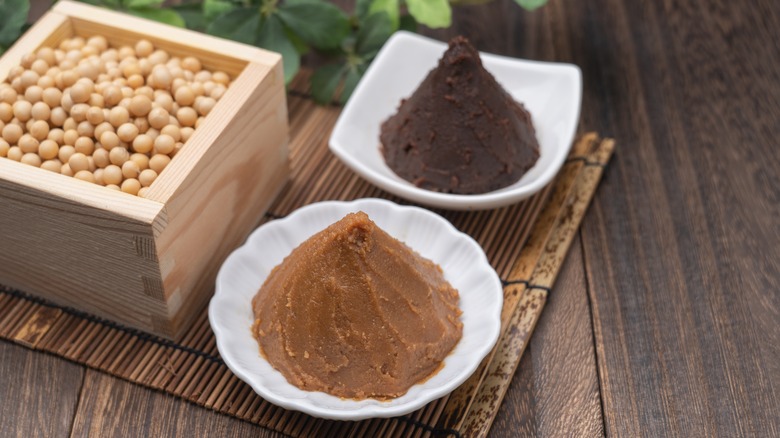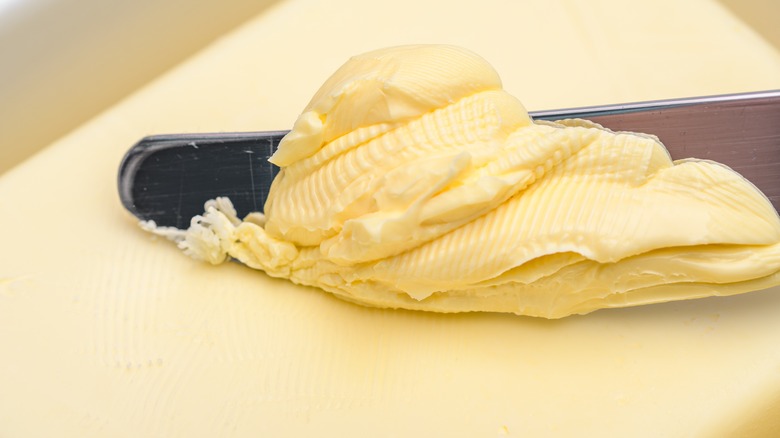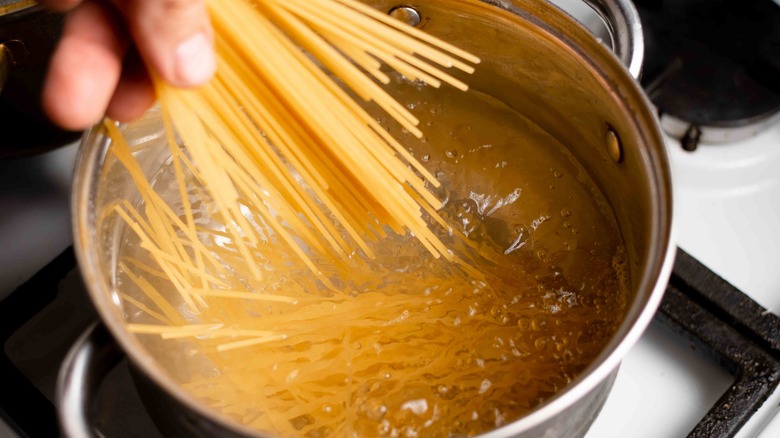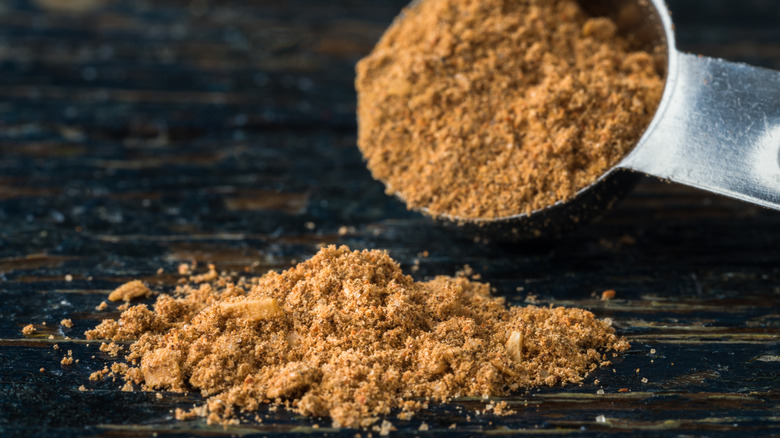15 Ingredients That Will Seriously Upgrade Your Spaghetti Sauce
Spaghetti is nothing without its sauce; the two have been satisfying diners together for hundreds of years. Classic tomato-based spaghetti sauce, also known as marinara sauce, has been documented in recipe books since the late 1600s, and its combination with pasta followed soon after, with Francesco Leonardi's "L'Apicio Moderno" listing a pasta with tomato sauce recipe in 1790. While recipes can vary from chef to chef, a basic spaghetti sauce is usually a combination of tomatoes, a fat like olive oil or butter, and additional seasonings like salt, pepper, and garlic. Basil is a frequent component of the sauce, and chopped onions usually make an appearance, too, with both of them adding further dimension to your meal.
Spaghetti sauce doesn't need a lot of adornments, but there are a few choice ingredients that can utterly transform its taste. The versatility of the base sauce, with its notes of sweetness, saltiness, and umami, lends itself to being stretched one way or the other. Certain additions can bring out the sauce's slight peppery notes, making it even spicier, or add a smoky dimension that you didn't know you needed — even when you're using a jarred spaghetti sauce, which can frequently be amped up to be made even better. Let's take a look at the best ingredients for the job.
1. Add parmesan rinds for rich flavor
Parmesan and spaghetti sauce are a match made in heaven, with the intense umami and tang of the cheese helping to add an entirely new layer of flavor to the dish. But if you want those flavor notes in the sauce itself, there's an easy way to achieve it. Instead of throwing away leftover parmesan rinds, save them up and drop them into your spaghetti sauce. Upon being simmered, the rinds will release their concentrated flavor into the sauce, giving it extra richness.
If you're worried about the rind melting, don't be. While the rind will soften up a little once it's heated, it won't disappear entirely. Parmesan rinds will also serve to thicken everything and make an excellent choice for a sauce that has too much water in it as a means to bulk it out without reducing flavor. If you don't have parmesan rinds, you can use almost any hard cheese rind you have to hand. Using cheese rinds is also a great way to cut down on food waste. You can do this with both homemade sauces and jarred pasta sauces, too — just simmer the latter in a pot with your rinds for five minutes before serving for seriously intense flavor.
2. Bulk it out with extra vegetables
Spaghetti sauce's appeal may lie in its simplicity, but that simplicity can often come at a cost. In jarred spaghetti sauces specifically, their flavor can be generated by added sugar or sodium, and they can be frustratingly low in nutrients like fiber, vitamins, and minerals. But adding in extra vegetables can be a great way to add flavor without relying on additives and make your spaghetti sauce healthier.
Vegetables like zucchini and eggplant work particularly well in spaghetti sauces. Both of them are an easy shape to work with, making it simple to chop them. They also both work well with tomato flavors and impart a subtle, meaty taste to your sauce. If you prefer more crunch in your marinara, try dicing up a few ribs of celery or chopped carrot and simmering it in your sauce briefly before serving. Celery will give your sauce a slightly herbal, grassy note, while carrots can add extra sweetness.
3. Sauté some garlic and stir it in
Garlic is an essential flavor in many spaghetti sauces, but some jarred options out there just don't pack the punch you're looking for. Luckily, there's a quick and easy way to amp up the allium. Just grab a pan and sauté some chopped garlic in it briefly before stirring it into the spaghetti sauce for an instant lift of flavor.
While you can also stir raw garlic into your sauce, be aware that the extra step of sautéing it first will likely give you the flavor you're craving. Cooking garlic prevents it from being too bitter or sharp and gives it a gentle, sweet, complex flavor that lifts meals so well. Sautéing garlic will also brown it slightly, giving a lightly caramelized, toasty note to its taste, which you won't get if you simmer raw garlic in your sauce. Remember, though, that garlic can burn incredibly quickly when it's sautéed, especially when there's nothing else in the pan to diffuse the heat. Make sure to cook it on low heat and use plenty of oil so it doesn't stick — as a bonus, you'll get loads of garlic-infused oil in your sauce, too.
4. Balsamic vinegar gives depth and tang
Red wine is frequently added to pasta sauces to give them a more complex flavor. But there's another richly-colored liquid out there that can do a similar thing. Adding balsamic vinegar, which is also made with grapes, to spaghetti sauce is an excellent way to bring out the dish's tangier notes. Balsamic vinegar has a way more developer flavor than other kinds of vinegar, with a nuttiness, slight sweetness, and almost a woodiness that stops it from just being merely acidic.
Balsamic vinegar is a good choice for spaghetti sauces that taste too salty, as both the astringency of the vinegar and its sweetness can cut through any excess sodium. Like wine, though, there are good and bad bottles of balsamic vinegar, and it's crucial to select carefully. One key thing to look for is a DOP label on your bottle. This abbreviation stands for Denominazione d'Origine Protetta and assures that the balsamic vinegar you're buying is made in specific regions in Italy in accordance with rigorous production standards. If you want a genuinely complex flavor, look for bottles labeled with vecchio or extravecchio, which will indicate that the vinegar has been aged for 12 or 25 years.
5. Anchovies will bump up the umami
Anchovies are a speedy way to give any spaghetti sauce a tremendous amount of flavor. Along with chili flakes and olives, they're a crucial part of puttanesca sauce, a classic Italian pasta sauce known for its robust flavors and ease of preparation. Puttanesca gained popularity in post-war Naples, thanks to most of the key ingredients coming in jars or cans, therefore making it easy to make when fresh supplies were limited.
On their own, anchovies can taste overly fishy and smell pungent, but they have a considerable amount of umami flavor in them. When anchovies are cooked, the umami disperses into the dish you're making, mellowing the fishiness out and leaving you with rich, savory flavors. When they're cut into small pieces, anchovies also have a tendency to dissolve into a sauce, so you don't have to worry about getting a big chunk of fish in your spaghetti. If you've never used them before, though, it's good to start carefully, as these little fish have a significant impact. Start with one anchovy fillet in your sauce, and add more if necessary.
6. For complexity, add gochujang
We're all about finding unexpected ingredients that work wonders, and in spaghetti sauce, gochujang is maybe our favorite. Gochujang is a bright-red, fermented Korean chili paste, which has a thick, treacly consistency. Made with sweet rice flour, rice syrup, and loads of salt, it packs a great deal of flavor into a very small quantity. Gochujang covers a broad swathe of flavor notes, with saltiness, heat, sweetness, umami, and funk all being provided in one spoonful.
Gochujang is a surprisingly natural fit with pasta, and you can whip up a quick gochujang sauce with a spoonful or two of the paste and some cream. However, it can also be added to ready-made spaghetti sauces, with the chili flavors a natural fit with tomatoes. Gochujang also works very well with parmesan, with the slight funkiness, salt, and umami of the cheese pairing seamlessly with the chili paste. If you don't have any gochujang, another Korean paste, doenjang, also works brilliantly. Doenjang is made from fermented soybeans and like miso, can give your spaghetti sauce a boost of umami taste while not being nearly as spicy as gochujang.
7. Stir in some olive oil
If you're making a homemade spaghetti sauce, you've likely used olive oil to make it. But if you're working with a jarred sauce, don't forget about its flavor-boosting power – or its importance in the dish itself. "Olive oil is fundamental to almost every Italian dish. Not just because it helps the sauce amalgamate, but because it adds so much flavor," says Trattoria Del Moro chef Emiliana Livi on HuffPost. In Italian cooking, olive oil acts as the base for all the other flavors and provides the necessary fat content without being too heavy.
Olive oil also adds vital flavor notes, with a slight piquancy and pepperiness that other fats don't provide. Yet despite this, many jarred pasta sauces don't contain any olive oil. Walmart's Great Value Traditional Pasta Sauce, for example, uses vegetable oil made from a combination of soybean, canola, and cottonseed oils. This may help to keep it cost-effective, but it's not very traditional and certainly won't make it taste better.
Luckily, adding olive oil to a jarred pasta sauce is as simple as stirring some in before serving. Remember, Italian cooking is never shy about adding oil to dishes in plentiful quantities, so don't be scared to pour in a little more than you usually would.
8. Red wine will give it a restaurant taste
Finding ways to make jarred spaghetti sauce more interesting can be tricky. But a quick and easy way to do so is to add a glug of red wine. Red wine is a standard addition to many pasta sauces, and while it's not strictly necessary in a marinara sauce, it can give it instant depth. And while it can seem somewhat counterintuitive to pair an acidic element, like wine, with an already-acidic sauce, doing so can actually cause things to taste less astringent overall. Furthermore, cooking tomatoes makes them less acidic, so you can worry less about tipping the balance with the wine you add.
In terms of which wine to pick, though, it's best not to use something that's too sour. "With dishes where the tomatoes are cooked or stewed, I would stay with high-acid reds that are not tannic or aggressive. These would be Italian reds like barbera or traditional Chianti," advises sommelier Nadine Brown to the Washington Post. Remember to cook the sauce a little once you've added your wine. If you don't, the alcohol will remain unevaporated and will, therefore, be too punchy and intense in your dish.
9. Grab some dried herbs
Nothing lifts a pasta sauce quite like herbs do. Herbs give a flavor dimension to spaghetti sauce without having to add items that can skewer the nutritional impact of the dish. In both premade and homemade spaghetti sauces, using choice herbs like oregano and basil can give them added brightness and amp up the natural flavor of the tomatoes.
Dried herbs are beneficial with cheaper jarred sauces that might skimp on added flavor elements to make them taste a little bit fancier. Just make sure that you simmer the sauce for a few minutes after adding your herbs, as they will need to cook to release their delicious oils into the dish. Cooking the herbs will also soften them, so you don't end up crunching on a piece of oregano midway through your meal. Fresh herbs can be added to a jarred pasta sauce if you have any on hand. Just make sure that you add them just before you're ready to serve, as cooking fresh herbs for too long can flatten their taste.
10. For smokiness, add paprika or chiles
Smokiness is a key flavor component in some dishes and an underrated flavor element in others. And although you might not think that spaghetti sauce needs smoky flavors, you'd be surprised at how much it lifts the dish. Smokiness in a spaghetti sauce stops it from tasting too salty or sugary and gives it a much fuller, more well-rounded taste.
It's also surprisingly easy to achieve with a few simple additions. The fastest way to add smokiness is with a few dashes of smoked paprika. The smoking process that the peppers undergo to make smoked paprika heightens their flavor, which will give your spaghetti sauce a richer, more savory taste. Chipotles, either powdered or from a jar, can also give your spaghetti sauce profound smokiness. Jarred chipotles have more of a full-bodied flavor than paprika does, and so may be a better choice if you want your sauce to have more impact. Just remember that chipotles can also be very spicy, and so you'll get heat as well as smoke.
11. A little brine will add layers
Tomato-based spaghetti sauce is known for its bright, fresh flavors, but it can also sometimes be a little one-note and lack any significant development. So, to give your spaghetti sauce another dimension, add brine. Brines, such as those that olives or capers bathe in, are complex liquids. While they start as a basic mixture of water, vinegar, and salt, they take on the notes of the food they contain over time and become something that's packed with instant flavor.
Olive brine, in particular, is excellent for use in a marinara sauce. The liquid adds an instant pop of umami, and its natural flavors tie in perfectly with any olive oil you're using, stopping it from being distracting. You can use brine from jars of both black and green olives, although the two will have distinct flavor notes: Black olive brine will have a bit more mellowness to it, whereas green olive brine will usually be sharper and taste fresher. Using olive brine is also a resourceful move to use up a food item that you'd usually just throw out. However, before you throw it into your sauce with wild abandon, make sure you test it first — some brines can be pretty salty, and you don't want to unbalance your sauce.
12. Miso gives you added umami and funk
If you want a deep-tasting pasta sauce, miso is your best friend. This classic fermented Japanese soybean paste is a surprisingly effective tool in spaghetti sauces, thanks to its supremely high levels of umami. As the soybeans used to make miso ferment, the amino acids in their proteins break down, forming umami-packed molecules that only get more intense the older the miso gets. While this might sound overwhelming for a simple pasta sauce, using just a small amount will give it an undertone of flavor that will heighten everything else in the dish. Miso also has a smooth, velvety texture, so adding it in will give your sauce an added body and can help to thicken it if it's too thin.
Keep in mind, however, that there are several different types of miso, and each one has a slightly different flavor profile. White miso is the variety that's been aged for the least amount of time and so has the subtlest flavor. Yellow miso is aged for longer, so it's more intense, and red miso is by far the most impactful flavor-wise, having been aged the longest. Interestingly, however, red miso is probably the best choice for your pasta sauce, as its robust flavor stands up well against the strong tastes of tomato, garlic, and wine.
13. Butter will provide flavor and texture
We're pretty happy to advocate adding butter to everything, but especially to spaghetti sauce. Butter gives spaghetti sauce a rich, creamy flavor that's hard to emulate with any other fat and helps to underpin the bright flavors in the sauce. The smoothness of the fat also gives your sauce a velvetiness that, again, is difficult to get using any other ingredient. Butter is also especially useful for folks who are lactose intolerant due to its very low lactose content – so it can be a great way to add smoothness without having to resort to milk or cream.
To get the best result from butter, though, you need to pick the best kind. Try to find a butter that's higher in butterfat, as this is what gives it its flavor. You should also select butters that use as few ingredients as possible in their production — the more ingredients listed, the more likely it will have been made with lower-quality items or with other fats. Butter labeled slow churn or small batch will likely be a better choice, as these products will have less air in them, giving you more bang for your buck.
14. Add pasta water for extra silkiness
One of the best ingredients to add to spaghetti sauce might come from your spaghetti itself. Your pasta water should never be entirely discarded after the noodles have cooked, and instead, you should reserve a small amount and add it to your sauce. When you cook pasta, its starch dissipates into the water, and when you add it to the sauce, the starch serves to thicken it and make it glossier. This added starch also makes it easier for the sauce to stick to your pasta when added, making your dish all the more cohesive.
Make sure you take your pasta water out just before you're about to drain your noodles, as this will give them the most time possible to release starch. If you're cooking a big pot of sauce, add about a cup or two of water; smaller portions might need less water. Additionally, keep in mind how much you've salted your pasta water. If you've made it especially briny, which is helpful to flavor your pasta, adding too much can leave you with an oversalted sauce. To avoid this happening, hold off on adding too much salt until after you've added the pasta water, and then adjust your seasonings if necessary.
15. Taco seasoning will add surprising flavor notes
You might not think that taco seasoning and spaghetti sauce are a natural fit together, but we'd urge you to give it a try. Adding taco seasoning to spaghetti sauce can give it a Tex-Mex kick that gives your dish added spice and layers of flavor. Many of the spices in taco seasoning, like cumin, garlic powder, and onion powder, go excellently with tomatoes and give the sauce extra heft. Other ingredients, like chili flakes and cayenne pepper, will add some heat to the sauce.
Taco seasoning is, in our opinion, best added liberally to spaghetti sauce to give the dish a clear and exciting twist. When combined with ground beef and onions, taco seasoning will make a spaghetti sauce into a substantial Southwestern-style meal. Add some shredded Monterey Jack on top, and you're good to go. Just remember that some taco seasonings have flour or cornstarch mixed into them to help them stick to the meat, and this can thicken your spaghetti sauce more than you might like.
